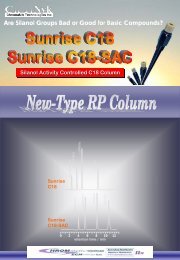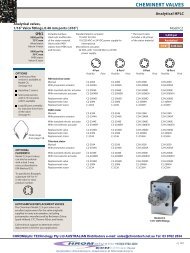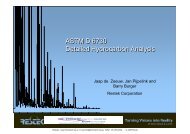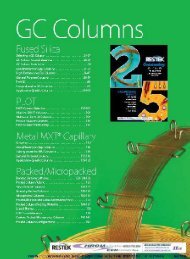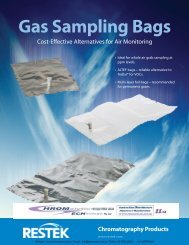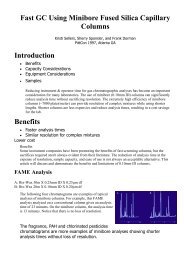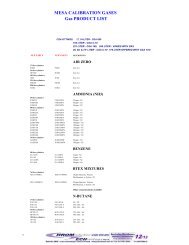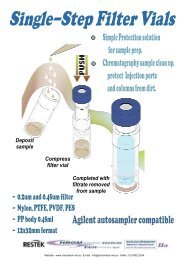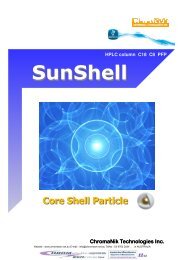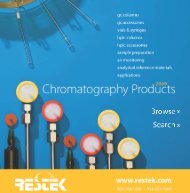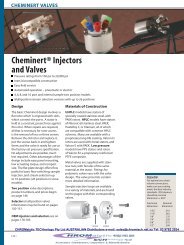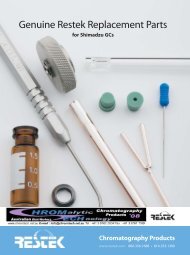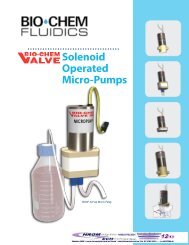Create successful ePaper yourself
Turn your PDF publications into a flip-book with our unique Google optimized e-Paper software.
<strong>GC</strong> COLUMNS | CAPILLARY COLUMNS<br />
Selecting a <strong>GC</strong> Column<br />
Selection of Capillary Column Summary<br />
Selecting a capillary column for an analysis can be done by following these basic steps:<br />
1)Choose the proper phase for the compounds being chromatographed<br />
a. Review the application section of this catalog or www.restek.com/chromatograms<br />
for similar compound list.<br />
b. Call Restek’s experienced technical support team (800-356-1688, ext. 4)<br />
or e-mail us at:<br />
• support@restek.com (in the USA)<br />
• intltechsupp@restek.com (international)<br />
• or contact your Restek representative.<br />
2)Select column ID, film thickness, and length<br />
a. Base choice on:<br />
• Injection technique (split, splitless, cool on-column, etc.)<br />
• Detector type (is low flow required)<br />
• Amount of analyte being injected onto column (sample capacity)<br />
3)Set optimum parameters for your analysis<br />
a. Optimize column flow (mL/min.)<br />
b. Choose appropriate carrier gas (hydrogen, helium, or nitrogen)<br />
c. Optimize oven temperature program<br />
Chromatogram<br />
Search Tool<br />
Search by compound name, synonym,<br />
CAS # or keyword<br />
www.restek.com/chromatograms<br />
What Are the Operating Temperatures for My Column<br />
All Restek columns have published minimum and maximum operating temperatures<br />
that establish the working range for the stationary phase. Note that these ranges vary<br />
with the thickness of the coating.<br />
Rtx®-VMS (fused silica)<br />
ID df (µm) temp. limits<br />
0.25mm 1.40 -40 to 240/260°C<br />
0.32mm 1.80 -40 to 240/260°C<br />
0.45mm 2.55 -40 to 240/260°C<br />
0.53mm 3.00 -40 to 240/260°C<br />
The minimum operating temperature defines the<br />
lowest usable temperature before the stationary<br />
phase solidifies. Operating the column below the<br />
minimum temperature will not harm the phase, but<br />
poor peak shape and other chromatography problems<br />
may occur.<br />
Many phases list 2 maximum operating temperatures.<br />
The first temperature is the maximum isothermal<br />
operating temperature. This is the temperature to<br />
which the columns are guaranteed to meet the minimum<br />
bleed specification (i.e., lowest bleed level). The<br />
second temperature is the maximum temperatureprogrammed<br />
operating temperature, the temperature<br />
to which the column can be heated for short periods<br />
of time (i.e., during a temperature-programmed<br />
analysis). If only one temperature is listed, it is both<br />
the isothermal and the maximum temperature.<br />
need more help<br />
• Call 800-356-1688 or<br />
814-353-1300, ext. 4,<br />
or your Restek<br />
representative.<br />
• Visit www.restek.com<br />
• Email (U.S.):<br />
support@restek.com<br />
Email (outside U.S.):<br />
intltechsupp@restek.com<br />
26 www.restek.com<br />
Website : www.chromtech.net.au E-mail : info@chromtech.net.au TelNo : 03 9762 2034 . . . in AUSTRALIA Mar 2011



